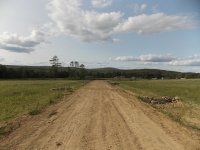I just use earthen humps on an angle, terminating the downhill ends with rip-rap to keep erosion at bay as it diverts road surface water into the ditch. I then put an rock check dam in the ditch, across the ditch, to prevent ditch erosion. (These can be seen in the photo)
I do that just because I plow my Heavy Haul Roads all winter, and figure if I plow them out, I can put the angled swales back for free, instead of having a rubber razor or box culvert to replace at a cost.
I think it looks professional, and is functional, but what "looks good" is subjective.
For what it is worth, this road, on a 9% grade, in soil characterized as Highly Erodible Soil, was approved by the US Dept of Agriculture, and met the Federal Soil Engineer's specifications for this road. The right side rock check dams have nothing to do with the swales; they are just for ditch erosion control, but the left side is just for erosion control of the water being diverted to the ditch by the swales. Just as a note, this road looks flat, but truly is a 9% grade, which is about the maximum a truck should be climbing/descending. The photo is an optical illusion.

